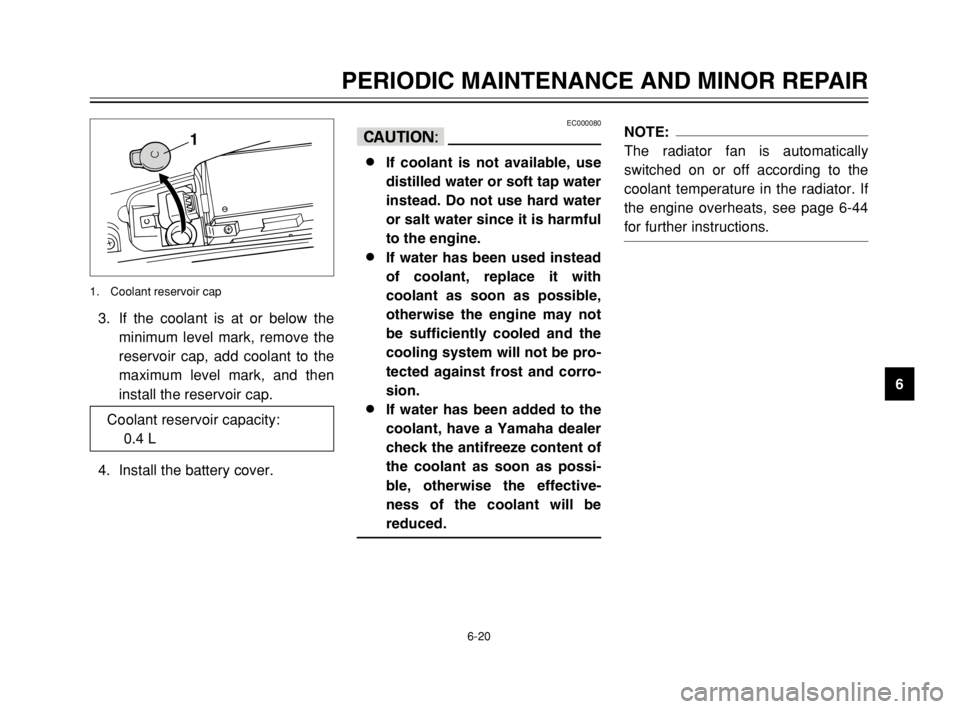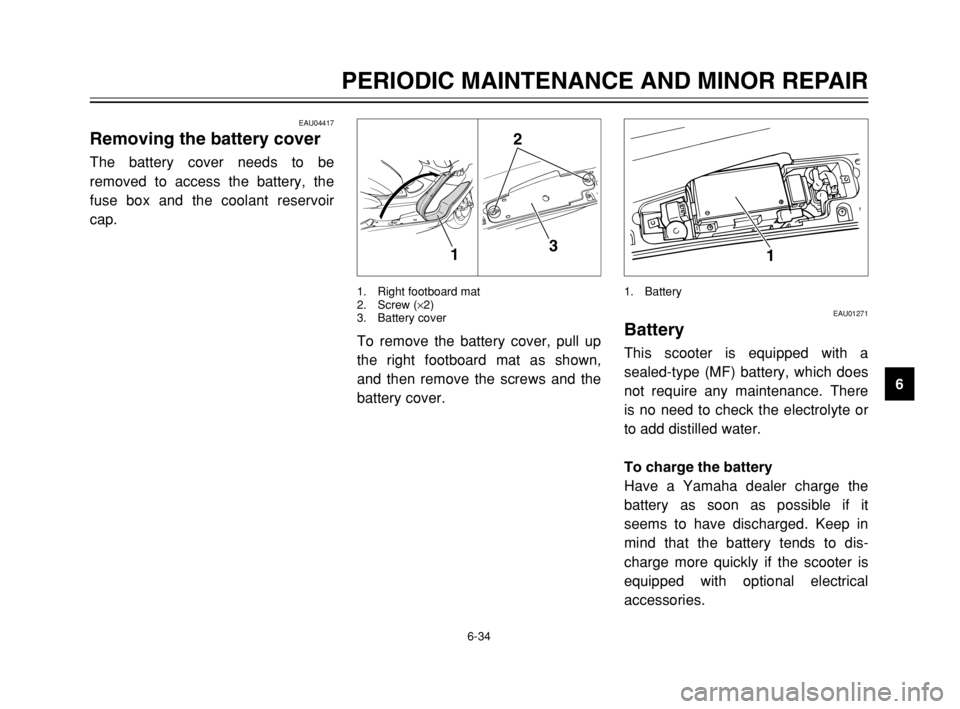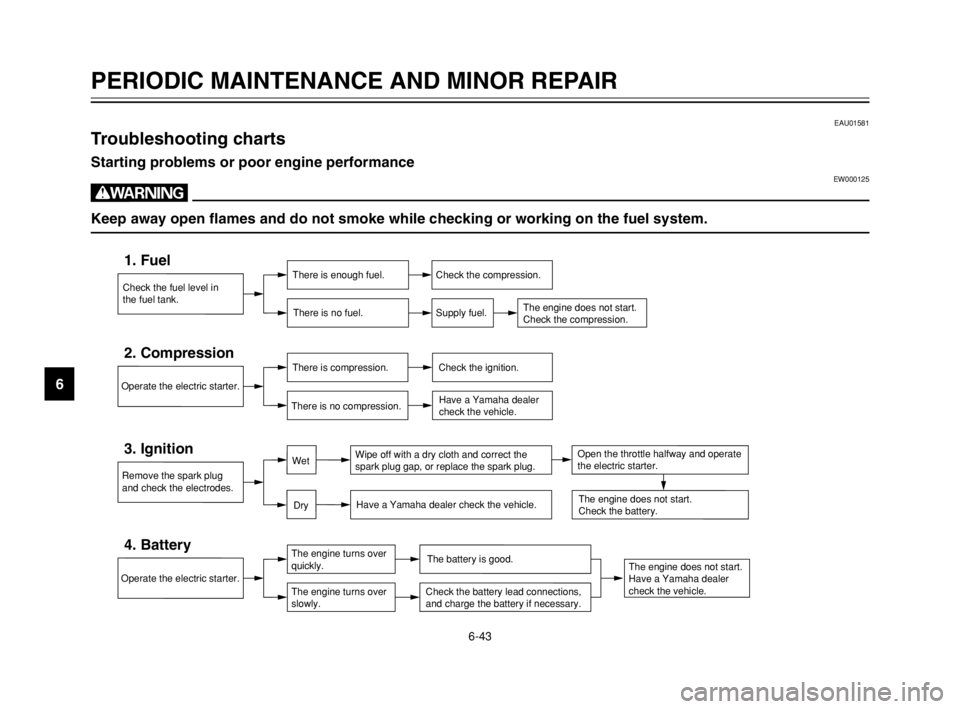2003 YAMAHA MAJESTY 250 battery
[x] Cancel search: batteryPage 71 of 116

6-20
PERIODIC MAINTENANCE AND MINOR REPAIR
6 3. If the coolant is at or below the
minimum level mark, remove the
reservoir cap, add coolant to the
maximum level mark, and then
install the reservoir cap.
4. Install the battery cover.
1
1. Coolant reservoir cap
NOTE:
The radiator fan is automatically
switched on or off according to the
coolant temperature in the radiator. If
the engine overheats, see page 6-44
for further instructions.EC000080
cC
8
8
If coolant is not available, use
distilled water or soft tap water
instead. Do not use hard water
or salt water since it is harmful
to the engine.
8 8
If water has been used instead
of coolant, replace it with
coolant as soon as possible,
otherwise the engine may not
be sufficiently cooled and the
cooling system will not be pro-
tected against frost and corro-
sion.
8 8
If water has been added to the
coolant, have a Yamaha dealer
check the antifreeze content of
the coolant as soon as possi-
ble, otherwise the effective-
ness of the coolant will be
reduced.
Coolant reservoir capacity:
0.4 L
5SJ-28199-E1 7/11/02 11:03 AM Page 69
Page 85 of 116

6-34
PERIODIC MAINTENANCE AND MINOR REPAIR
6
EAU04417
Removing the battery coverBattery cover removalThe battery cover needs to be
removed to access the battery, the
fuse box and the coolant reservoir
cap.
EAU01271
BatteryBatteryThis scooter is equipped with a
sealed-type (MF) battery, which does
not require any maintenance. There
is no need to check the electrolyte or
to add distilled water.
To charge the battery
Have a Yamaha dealer charge the
battery as soon as possible if it
seems to have discharged. Keep in
mind that the battery tends to dis-
charge more quickly if the scooter is
equipped with optional electrical
accessories.
1
1. Battery
To remove the battery cover, pull up
the right footboard mat as shown,
and then remove the screws and the
battery cover.
2
3
1
1. Right footboard mat
2. Screw (×2)
3. Battery cover
5SJ-28199-E1 7/11/02 11:03 AM Page 83
Page 86 of 116

6-35
PERIODIC MAINTENANCE AND MINOR REPAIR
6
EW000116
w
8 8
Electrolyte is poisonous and
dangerous since it contains
sulfuric acid, which causes
severe burns. Avoid any con-
tact with skin, eyes or clothing
and always shield your eyes
when working near batteries.
In case of contact, administer
the following FIRST AID.
9 9
EXTERNAL: Flush with
plenty of water.
9 9
INTERNAL: Drink large
quantities of water or milk
and immediately call a
physician.
9 9
EYES: Flush with water for
15 minutes and seek prompt
medical attention.To store the battery
1. If the scooter will not be used for
more than one month, remove
the battery, fully charge it, and
then place it in a cool, dry place.
2. If the battery will be stored for
more than two months, check it
at least once a month and fully
charge it if necessary.
3. Fully charge the battery before
installation. 8 8
Batteries produce explosive
hydrogen gas. Therefore, keep
sparks, flames, cigarettes,
etc., away from the battery and
provide sufficient ventilation
when charging it in an
enclosed space.
8 8
KEEP THIS AND ALL BATTER-
IES OUT OF THE REACH OF
CHILDREN.
5SJ-28199-E1 7/11/02 11:03 AM Page 84
Page 87 of 116

6-36
PERIODIC MAINTENANCE AND MINOR REPAIR
6
EC000102
cC
8
8
Always keep the battery
charged. Storing a discharged
battery can cause permanent
battery damage.
8 8
To charge a sealed-type (MF)
battery, a special (constant-
voltage) battery charger is
required. Using a conventional
battery charger will damage
the battery. If you do not have
access to a sealed-type (MF)
battery charger, have a
Yamaha dealer charge your
battery.
1. Turn the key to “OFF” and turn
off all electrical circuits.
2. Remove the blown fuse, and
then install a new fuse of the
specified amperage.
EC000103
cC
Do not use a fuse of a higher
amperage rating than recommend-
ed to avoid causing extensive
damage to the electrical system
and possibly a fire.
EAU04110*
Replacing the fusesFuses, replacingThe fuse boxes are located under the
battery cover. (See page 6-34 for bat-
tery cover removal and installation
procedures.)
If a fuse is blown, replace it as fol-
lows.
4
5
79
6
18
3
2
910
1. Main fuse
2. Backup fuse (clock)
3. ABS control unit fuse
4. Radiator fan fuse
5. Ignition fuse
6. Headlight fuse
7. Signaling system fuse
8. ABS motor fuse
9. Spare fuse (×5)
10. Spare main fuse
Specified fuses:
Main fuse: 30 A
Backup fuse (clock): 10 A
ABS control unit fuse: 10 A
Radiator fan fuse: 4 A
Ignition fuse: 7.5 A
Headlight fuse: 15 A
Signaling system fuse: 15 A
ABS motor fuse: 30 A
5SJ-28199-E1 7/11/02 11:03 AM Page 85
Page 94 of 116

6-43
PERIODIC MAINTENANCE AND MINOR REPAIR
6
EAU01581
Troubleshooting chartsTroubleshooting chartsStarting problems or poor engine performanceEW000125
w
Keep away open flames and do not smoke while checking or working on the fuel system.
Check the fuel level in
the fuel tank.
1. FuelThere is enough fuel.
There is no fuel.Check the compression.
Supply fuel.
The engine does not start.
Check the compression.
Operate the electric starter.
2. CompressionThere is compression.
There is no compression.Check the ignition.
Have a Yamaha dealer
check the vehicle.
Remove the spark plug
and check the electrodes.
3. IgnitionWipe off with a dry cloth and correct the
spark plug gap, or replace the spark plug.
Have a Yamaha dealer check the vehicle.
The engine does not start.
Have a Yamaha dealer
check the vehicle.
The engine does not start.
Check the battery.
Operate the electric starter.
4. BatteryThe engine turns over
quickly.
The engine turns over
slowly.The battery is good.
Check the battery lead connections,
and charge the battery if necessary.
Dry
WetOpen the throttle halfway and operate
the electric starter.
5SJ-28199-E1 7/11/02 11:03 AM Page 92
Page 102 of 116

7-5
SCOOTER CARE AND STORAGE
75. Lubricate all control cables and
the pivoting points of all levers
and pedals as well as of the
sidestand/centerstand.
6. Check and, if necessary, correct
the tire air pressure, and then lift
the scooter so that both of its
wheels are off the ground.
Alternatively, turn the wheels a
little every month in order to pre-
vent the tires from becoming
degraded in one spot.
7. Cover the muffler outlet with a
plastic bag to prevent moisture
from entering it.8. Remove the battery and fully
charge it. Store it in a cool, dry
place and charge it once a
month. Do not store the battery
in an excessively cold or warm
place [less than 0 °C or more
than 30 °C]. For more informa-
tion on storing the battery, see
page 6-35.
NOTE:
Make any necessary repairs before
storing the scooter.
5SJ-28199-E1 7/11/02 11:03 AM Page 100
Page 106 of 116

8-3
SPECIFICATIONS
8
90 kg load–maximum load*
Front200 kPa (2.00 kgf/cm
2, 2.00 bar)
Rear225 kPa (2.25 kgf/cm
2, 2.25 bar)
* Total weight of rider, passenger, cargo and accessories
Wheels
Front
Type Cast wheel
Size 12 ×MT2.75
Rear
Type Cast wheel
Size 12 ×MT3.50
Brakes
Front
Type Single disc brake
Operation Right hand
Fluid DOT 4
Rear
Type Single disc brake
Operation Left hand
Fluid DOT 4Suspension
Front Telescopic fork
Rear Unit swing
Spring/shock absorbers
Front Coil spring/oil damper
Rear Coil spring/oil damper
Wheel travel
Front 100 mm
Rear 90 mm
Electrical
Ignition system Transistorized coil ignition
(digital)
Charging system
Type A.C. magneto
Standard output 14 V, 19.5 A @ 5,000 r/min
Battery
Type GT7B-4
Voltage, capacity 12 V, 6.5 AH
Headlight bulb typeHalogen bulb
5SJ-28199-E1 7/11/02 11:03 AM Page 104
Page 112 of 116

INDEX
D
Display, multi-function ............................3-5
E
Engine break-in ......................................5-4
Engine oil ..............................................6-14
F
Final transmission oil ............................6-18
Front and rear brake lever free play,
adjusting ...........................................6-27
Front and rear brake pads, checking ....6-28
Front fork, checking ..............................6-32
Fuel ......................................................3-16
Fuel consumption, tips for reducing .......5-4
Fuel gauge .............................................3-5
Fuel tank cap ........................................3-15
Fuses, replacing ...................................6-36
H
Handlebar switches ..............................3-10
Dimmer switch ..................................3-10
Engine stop switch ............................3-11
Horn switch .......................................3-10
Pass switch .......................................3-10
Start switch .......................................3-11
Turn signal switch .............................3-10
Headlight bulb, replacing ......................6-37I
Identification numbers ............................9-1
Ignition circuit cut-off system ................3-22
Indicator and warning lights ....................3-2
ABS warning light ................................3-2
High beam indicator light .....................3-3
Oil change indicator light .....................3-3
Turn signal indicator lights ...................3-2
K
Key identification number .......................9-1
L
License plate light bulb, replacing ........6-41
M
Main switch/steering lock .......................3-1
Model label .............................................9-2
P
Parking ...................................................5-5
Part locations ..........................................2-1
Periodic maintenance and lubrication
chart .....................................................6-3
Pre-operation check list ..........................4-1
R
Rider seat .............................................3-18
Rider seat, adjusting .............................3-18A
ABS ......................................................3-13
Acceleration and deceleration ................5-3
Air filter and V-belt case air filter
elements, cleaning ............................6-21
Air flow louver .......................................6-23
Anti-theft alarm (optional) .....................3-10
B
Battery ..................................................6-34
Battery cover removal ..........................6-34
Brake fluid level, checking ....................6-29
Brake fluid, changing ............................6-30
Brake lever, front ..................................3-11
Brake lever, rear ...................................3-12
Brake levers, lubricating .......................6-31
Braking ...................................................5-3
C
Cables, checking and lubricating ..........6-30
Care ........................................................7-1
Catalytic converter ................................3-17
Centerstand and sidestand, checking
and lubricating ..................................6-31
Conversion table ....................................8-5
Coolant .................................................6-19
Coolant temperature gauge ....................3-5
Cowlings and panel, removing and
installing ..............................................6-6
5SJ-28199-E1 7/11/02 11:03 AM Page 110